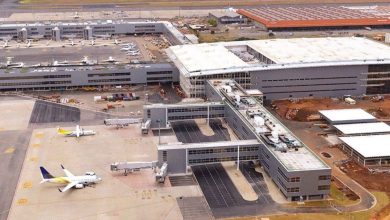Tráfego no Aeroporto de Dubai cresce para 22,5 milhões
Passenger traffic at Dubai International (DXB) climbed 7.4 per cent to 22.5 million in the first quarter, keeping the airport on track to meet its forecast of 89 million passengers in 2017. The world’s number one airport for international passenger traffic saw a 3.8 per cent increase in passenger numbers to 7.5 million in March compared to 7.237 million in March 2016.
The first-quarter traffic surge corresponded with the impressive 11 per cent surge to 4.57 million overnight tourist arrivals to the Dubai in the first three months. The growth was driven by tourist arrivals from China, Russia and India. The first quarter surge in inbound tourist traffic reflected more than double the growth achieved in the first quarter of 2016, Dubai Tourism announced at the Arabian Travel Market.
In a statement, DXB said the more modest growth rate in March was due to the timing of the Easter holiday which fell during March in 2016 and during April in 2017. Paul Griffiths, CEO of Dubai Airports said while there are fluctuations in growth market-by-market the overall trend is quite positive as evidenced by the 7.4 per cent increase in passenger numbers during the first quarter. “That result keeps us well on track to meet our 2017 forecast of 89 million passengers.”
The number of passenger flights in March grew 1.0 per cent to 34,634 compared to 34,303 last year while year-to-date flight numbers were up 0.5 percent to 100,638 compared to 100,116 recorded during the first quarter of 2016. The average number of passengers per flight in the first three months of the year was 224, compared to 209 during the corresponding period in 2016, an increase of 6.8 per cent.
Saj Ahmad, the chief analyst at London-based StrategicAero Research, said Dubai Internationals’s continued growth for the year shows no sign of abating. “Despite the earlier Easter period denting demand, as well as the impact of the US electronic device ban, the airport still demonstrated a robust 7.4 per cent passenger increase for the quarter over a year ago to 22.5 million,” Ahmad told Khaleej Times.
During the first three months of the year, Eastern Europe was the fastest expanding market in terms of percentage growth (33.3 per cent) as the appreciation of the ruble against the US dollar over the past year has increased spending power in Dubai and spiked demand in the Russian market. Asia was the next fastest growing market (22.6 per cent) which benefited from additional capacity provided by Emirates and flydubai in markets such as Thailand, China and the Philippines, followed by South America (22.2 per cent).
“Driven by demand for connecting flights through Emirates’ ever-expanding network as well as that of number two incumbent at the airport, flydubai, passengers are keen to use the hub as their gateway for travel and this performance suggests that 2017 will be another record breaking year for the airport,” Ahmad said.
The impact of travel bans and electronic device restrictions is starting to be felt on North American traffic figures, which were down 4.3 per cent during March of 2017 versus the same period last year. Year to date traffic to and from North America is up 2.5 per cent.
India remained the top destination country during the first three months of the year with a total of 3.031 million passengers, followed by the UK (1.618 million passengers), Saudi Arabia (1.572 million) and Pakistan (1.166 million).
London topped the list of destination cities during the period under review with 974,950 passengers, followed by Doha (797,729 passengers), Bangkok (633,496) and Mumbai (618,638).
Freight volumes were also on the rise in the first quarter of 2017 with 636,479 tonnes passing through DXB, up 3.5 per cent from the 615,144 recorded during the same period last year. This result was positively impacted by an 8.4 per cent boost in cargo volumes in March with 235,503 tonnes being handled compared to 217,202 tonnes in the same period last year.
Fonte: McClatchy 25/04/2017





